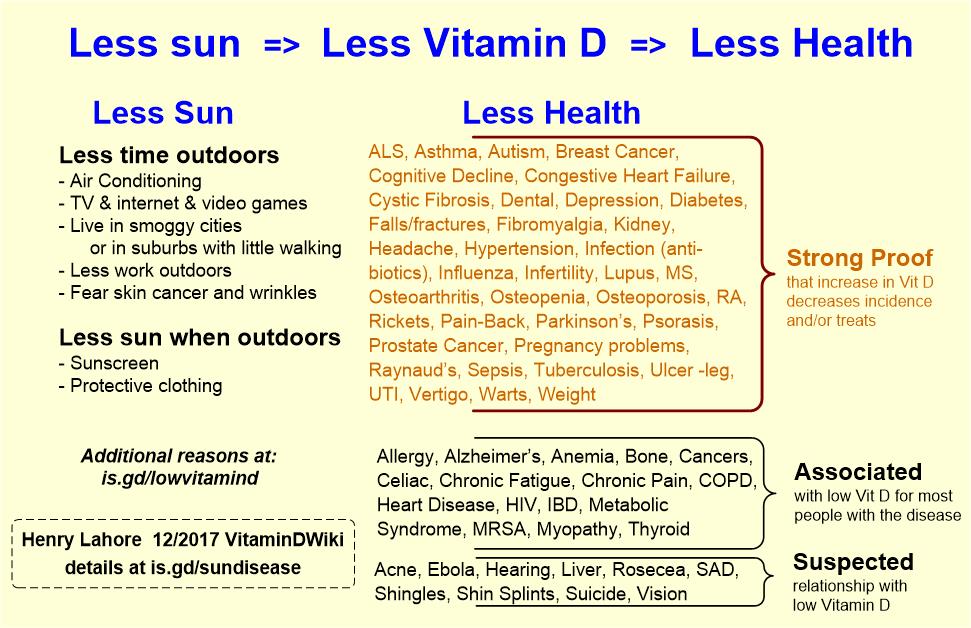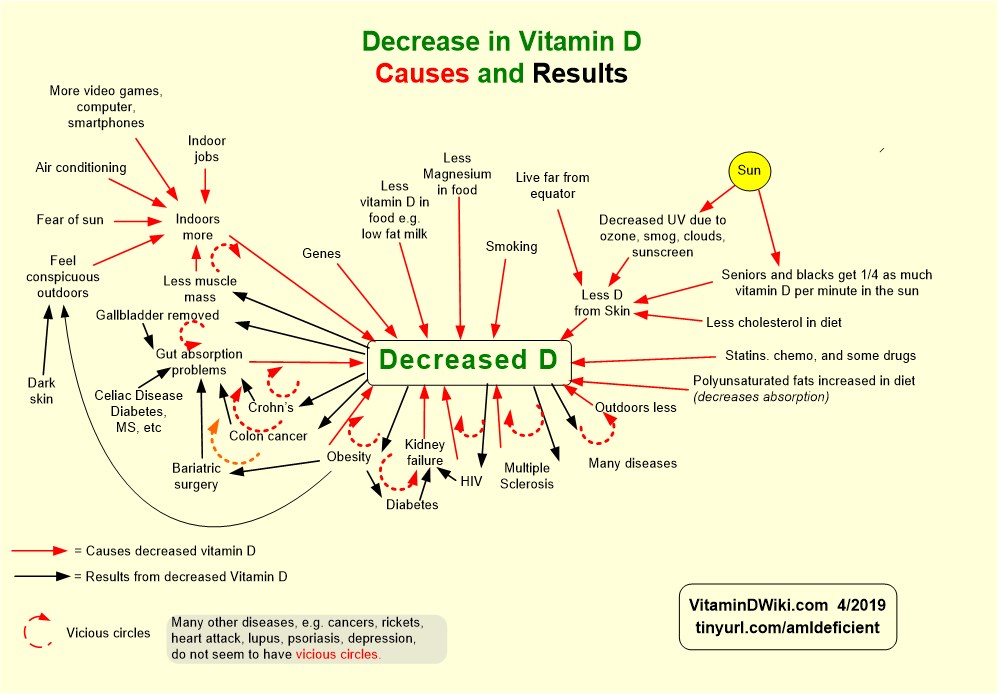Criteria to associate a health problem with low vitamin D
A large number of health probems are associated with low vitamin D - see left column or chart below
If a health problem has more than 7 of the following factors then I believe that vitamin D deficiency is the cause and addtional Vitamin D might prevent/treat it
It has increased significantly recently ( 2X in a decade on average)
Health problem increase has occured around the world, not just the US
Occurs more often when Far from Equator - but this factor has been decreasing during the past 20-30 years
- people can now stay indoors, thanks to air conditioning
- Season- problem is worse in Spring when the vitamin D in the blood is the lowest
- Can now also happen in the Summer in the tropics if you can afford the air conditioning to stay away from the hot sun.
Disease frequncy varies with Season of Birth
Overweight - fat ties up a lot of vitamin D and the obese often do not feel comfortable out of doors
Medical problems which reduce vitamin D - MS, kidney, gut, liver, kidney, Bariatric Surgery, Cancer,..
Dark skin - who get about 1/4 the amount of vitamin D per minute in the sun as those with light skin
Seniors - who also get about 1/4 of the vitamin D per minute similar to those with dark skins - for a different reason
Higher risk of the health problem if in another category for being at high-risk of being vitamin D deficient (besides overweight, senior, smoking, dark skin, shut-in) such as: pregnancy, excessive clothing, red-hair,
Atmospheric haze - which reduces the UVB getting to the people - typically in cities
Problem gets worse when taking a drug which reduces vitamin D
A Patent has been issued for Vitamin D to treat or prevent the health problem
- such as: Breast and many other cancers, Obesity, Bone loss, Prostate, Fall prevention, stroke and other Cardiovascular, Immune system, heal wounds and reduce scars, Kidney disease, Diabetes, improve fertility, decrease pregnancy problems, (SAD), multiple sclerosis, chemoprevention of cancer, accelerate fracture healing, metabolic syndrome, periodontitis, gingivitis, endometreosis, hair loss, asthma, allergy, etc.
The health problem is strongly associated with a vitamin D related disease
Worse around the age of weaning from formula which had been fortified with vitamin D
Is more common in rich families – who are more likely to apply sun screen,stay indoors, and want lighter skin
Health problem is REDUCED by Ultraviolet light - from sun or UVB bulbs
More in urban areas – less UVB in urban environments
Less at high altitude - where there is more UVB ( Colorado has the best UV (and thus best health) in the US )
Less if person works outdoors 8X more likely to die if work indoors (1915)
Worse in areas with increased clouds and rain - keeping people indoors, also, there is less UVB when outdoors
Worse if born less than 12 months after previous sibling or as a twin - both of which reduces infant vitamin D levels
A meta-analysis of the disease has found an association with low vitamin D
Intervention with vitamin D has been found the prevent or treat the disease
The following chart shows the current associations

Possible interactions and vicious circles

Hill's Criteria to associate a health problem with something like vitamin D
| Criterion | Defining Question |
| Strength of the association | Is there a large difference in the outcome between exposed and non-exposed persons? |
| Consistency of the observed association | Has the outcome been observed by multiple researchers, in various circumstances, places and at different times? |
| Specificity of the association | Are there specific persons or geographic locations associated with specific outcomes? |
| Temporality (temporal relationship of the association) |
Does the cause always precede the effect? |
| Biological gradient | Is there a dose-response curve? |
| Plausibility of the biology | Is the suspected causation consistent with current knowledge of biology? |
| Coherence | Are there any serious conflicts with the biology or natural history of the disease? |
| Experiment (experimental or quasi-experimental evidence) |
Has an observed association led to a preventive action that has prevented the outcome? |
| Analogy | Is there an analogous exposure and outcome? |
